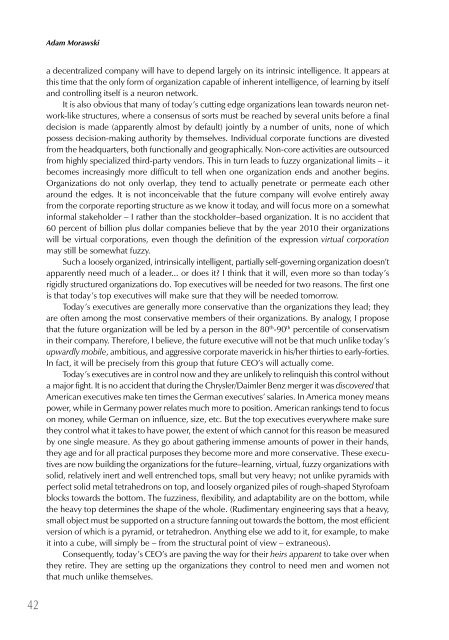Przerażony kameleon - eseje o przyszłości zarządzania - E-mentor
Przerażony kameleon - eseje o przyszłości zarządzania - E-mentor
Przerażony kameleon - eseje o przyszłości zarządzania - E-mentor
- TAGS
- kameleon
- eseje
- e-mentor.edu.pl
You also want an ePaper? Increase the reach of your titles
YUMPU automatically turns print PDFs into web optimized ePapers that Google loves.
42<br />
Adam Morawski<br />
a decentralized company will have to depend largely on its intrinsic intelligence. It appears at<br />
this time that the only form of organization capable of inherent intelligence, of learning by itself<br />
and controlling itself is a neuron network.<br />
It is also obvious that many of today’s cutting edge organizations lean towards neuron network-like<br />
structures, where a consensus of sorts must be reached by several units before a final<br />
decision is made (apparently almost by default) jointly by a number of units, none of which<br />
possess decision-making authority by themselves. Individual corporate functions are divested<br />
from the headquarters, both functionally and geographically. Non-core activities are outsourced<br />
from highly specialized third-party vendors. This in turn leads to fuzzy organizational limits – it<br />
becomes increasingly more difficult to tell when one organization ends and another begins.<br />
Organizations do not only overlap, they tend to actually penetrate or permeate each other<br />
around the edges. It is not inconceivable that the future company will evolve entirely away<br />
from the corporate reporting structure as we know it today, and will focus more on a somewhat<br />
informal stakeholder – I rather than the stockholder–based organization. It is no accident that<br />
60 percent of billion plus dollar companies believe that by the year 2010 their organizations<br />
will be virtual corporations, even though the definition of the expression virtual corporation<br />
may still be somewhat fuzzy.<br />
Such a loosely organized, intrinsically intelligent, partially self-governing organization doesn’t<br />
apparently need much of a leader... or does it? I think that it will, even more so than today’s<br />
rigidly structured organizations do. Top executives will be needed for two reasons. The first one<br />
is that today’s top executives will make sure that they will be needed tomorrow.<br />
Today’s executives are generally more conservative than the organizations they lead; they<br />
are often among the most conservative members of their organizations. By analogy, I propose<br />
that the future organization will be led by a person in the 80 th -90 th percentile of conservatism<br />
in their company. Therefore, I believe, the future executive will not be that much unlike today’s<br />
upwardly mobile, ambitious, and aggressive corporate maverick in his/her thirties to early-forties.<br />
In fact, it will be precisely from this group that future CEO’s will actually come.<br />
Today’s executives are in control now and they are unlikely to relinquish this control without<br />
a major fight. It is no accident that during the Chrysler/Daimler Benz merger it was discovered that<br />
American executives make ten times the German executives’ salaries. In America money means<br />
power, while in Germany power relates much more to position. American rankings tend to focus<br />
on money, while German on influence, size, etc. But the top executives everywhere make sure<br />
they control what it takes to have power, the extent of which cannot for this reason be measured<br />
by one single measure. As they go about gathering immense amounts of power in their hands,<br />
they age and for all practical purposes they become more and more conservative. These executives<br />
are now building the organizations for the future–learning, virtual, fuzzy organizations with<br />
solid, relatively inert and well entrenched tops, small but very heavy; not unlike pyramids with<br />
perfect solid metal tetrahedrons on top, and loosely organized piles of rough-shaped Styrofoam<br />
blocks towards the bottom. The fuzziness, flexibility, and adaptability are on the bottom, while<br />
the heavy top determines the shape of the whole. (Rudimentary engineering says that a heavy,<br />
small object must be supported on a structure fanning out towards the bottom, the most efficient<br />
version of which is a pyramid, or tetrahedron. Anything else we add to it, for example, to make<br />
it into a cube, will simply be – from the structural point of view – extraneous).<br />
Consequently, today’s CEO’s are paving the way for their heirs apparent to take over when<br />
they retire. They are setting up the organizations they control to need men and women not<br />
that much unlike themselves.

















